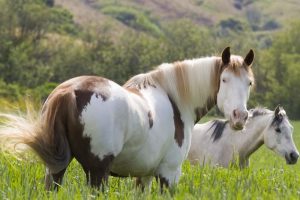-
 Return to Freedom’s Ambassadors
Return to Freedom’s Ambassadors
Our Ambassador horses are animals who have special attributes: They are rare breeds or purest of bloodlines or they’re world-famous. Together, they serve as living examples of the nobility and majesty of America’s wild horse.
On the morning of Oct. 8, 2018, we said goodbye to our beloved friend and ambassador Sutter, the palomino stallion with a heart of pure gold. Sutter was 32 years old.
Sutter has carried the dreams of so many and in sharing his story touched the hearts and minds of thousands of people who now know about the beauty, strength and nobility of the stallion, the American mustang and their fight to survive.
To read more about Sutter, and his incredible journey, please click:
https://returntofreedom.org/what-we-do/sanctuary/our-horses/gone-not-forgotten/


It’s with a heavy heart that we announce the passing of our magnificent liver bay roan stallion, Freedom. He died on March 12, 2022, at our Lompoc sanctuary. He was 24.
In 1998-99, the U.S. Fish and Wildlife Service removed all 275 of the wild horses from the Hart Mountain National Antelope Refuge in Oregon. RTF offered a safe haven for 25 of the wild horses. Because the horses were gathered on horseback, they were able to relocate the horses to our sanctuary in their natural family and bachelor bands.
Born in 1998, just after his sire, Mystic, and dam, Belle, were captured from Hart Mountain, Freedom was 6 months old when he arrived at the sanctuary.
Freedom grew to lead a family band of his own at the sanctuary alongside his lead mare, Adeer. An independent spirit all of his life, Freedom’s beauty and kindness made him a favorite for staff, visitors and photographers.


Isadora was named after the innovative dancer, Isadora Duncan. When Isadora was a young filly, she would be seen frolicking in the last rays of the sun as they filtered into her pasture at the end of the day.
These strong and reliable horses are direct descendants of Padre Kino’s original herd who arrived in America from Spain in the late 1600s.
Padre Kino arrived in Mexico in 1681 as a missionary and established a string of missions in the American Southwest. His main headquarters was the Mission Delores in Sonora Mexico where he became known for bringing the highest quality livestock over from Spain. Among his many talents, Padre Kino was a rancher and became dubbed the ‘Priest on Horseback,’ introducing cattle, mules, and horses to his parishioners and expanding their skills with architecture and ranching.
In 1885, a man named Dr. Reuben Wilbur purchased a herd of the horses originating from Rancho Delores. They were then isolated on the Wilbur-Cruce Ranch in southern Arizona for almost 100 years.
One notable difference with the Wilbur-Cruce strain, apart from other known strains of the Colonial Spanish horses, is that the population has always been privately managed, resulting in horses whose genetics are uninfluenced by modern breeds. This cannot be said of many other groups of horses with similar ancestry. They are the only known ‘rancher’ strain of pure Spanish horses that persists in the southwest. The Cruce population is a most significant discovery of a type of horse largely thought to be gone forever.
The historical and genetic value of these horses was recognized, and because of Dr. Wilbur’s granddaughter, Eva Cruce, and the American Minor Breeds Conservancy, the horses were placed into a program with conservation breeders in 1990.
Now referred to as the Wilbur-Cruce horses, they are part of Return to Freedom’s conservation efforts, and — along with the Sulphur Springs herd, the Choctaw horses, and other strains of Colonial Spanish horses — represent some of the original Spanish barb horses who returned to our continent some 500 years ago and were the foundation of what was called The Spanish Mustang in America.
Isadora, her sister, Ines, and four other Wilbur-Cruce horses live at Return to Freedom’s American Wild Horse Sanctuary in Santa Barbara County, California. Return to Freedom is dedicated to preserving the freedom, diversity and habitats of America’s wild horses through sanctuary, education, and conservation, while enriching the human spirit through direct experience with the natural world.
Return to Freedom works locally and nationally, on behalf of these complex and magnificent creatures, who embody a significant piece of our cultural heritage.
Picture Gallery of Isadora
A resident of Return to Freedom Wild Horse Sanctuary, this Cerbat stallion, Ambassador Amante (translated as: Fiery Lover), plays a significant role in the conservancy’s Conservation Program.
The Mustangs from the Cerbat Mountain (Wikipedia) area of northwestern Arizona are some of the purest Spanish descendants in the United States. With less than 70 living in the wild, and very few in domestic breeding programs, Amante is a rare find.
This handsome stallion had wandered off his range and managed to break into a neighboring ranch taking several mares back into the hills with him. The owner of the mares went through quite an ordeal to roundup them back up. Since his capture, this stallion has been held in a government (BLM) corral for three years looking back at freedom and the high snow covered peaks that were once his home.
For more information on the Mustangs of the Cerbat Mountain area, visit our Cerbat Herd page.












